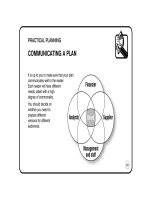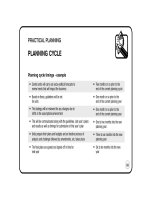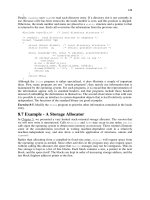Management pocketbooks the business planning pocketbook phần 8 doc
Bạn đang xem bản rút gọn của tài liệu. Xem và tải ngay bản đầy đủ của tài liệu tại đây (100.49 KB, 11 trang )
PRACTICAL PLANNING
STRUCTURING A PLAN
INTRODUCTION
75
Description of the organisation/unit
The company is engaged in brewing and the supply
of ancillary products such as soft drinks, spirits, etc.
It is split into four departments:
✹ Brewing (which makes the beer)
✹ Sales and marketing (which ensures it is sold)
✹ Distribution (which delivers supplies)
✹ Head office support (finance - including planning - HR, IT)
which provides infrastructure support
✹ All operations are located on one site
✹ It has its own transport fleet
✹ etc
PRACTICAL PLANNING
STRUCTURING A PLAN
MARKET ANALYSIS
76
The market is dominated by three very large brewers
with a few middle-sized, largely regional companies,
and several small organisations catering for local
areas or specialised beers.
✹ The industry’s tied sales have been reduced
drastically through legal requirements resulting in
the emergence of several large independent chains of
outlets
✹ The home sales market has increased substantially in
recent years through supermarkets, which has radically
changed the distribution dynamics and forced down prices
✹ Profits have been hit accordingly
✹ Profits are further under pressure from premium
bottled imported beers which have eaten into the
traditional draught market
✹ etc
PRACTICAL PLANNING
STRUCTURING A PLAN
MARKETING PLAN
77
Overall objectives:
✹ To increase sales in home consumption market by 15%
✹ As a minimum, retain position in free houses and increase
throughput by 5%
✹ Introduce two new beer products this year and one soft drink
✹ Expand geographical market into one new region - Scotland
✹ Tie up an agreement with local supermarket chain
✹ Sponsor one or two key local events
✹ etc
PRACTICAL PLANNING
STRUCTURING A PLAN
OPERATIONAL PLAN
78
Given the pressures within the market,
operations must:
✹ Increase efficiency by investing in new brewing plant
✹ Reduce operating costs by 25% or better
✹ Put in hand plans for the outsourcing of distribution
over the next two years
✹ Reduce brewing/delivery cycles by 10%
✹ etc
PRACTICAL PLANNING
STRUCTURING A PLAN
RESOURCE REQUIREMENTS
79
As per the strategy, key requirements are:
✹ Staff
- appoint a new head of finance and
administration
- recruit a planner
- recruit a new regional marketing director
for Scotland
✹ Capital investment
- replace existing plant
- if Scottish sales targets are made, consider buying
site north of the border for administration and
storage/distribution
✹ IT
- replace existing legacy system (finance and general ledger)
with package
- ensure systems are millennium compliant
✹ etc
PRACTICAL PLANNING
STRUCTURING A PLAN
APPENDICES
80
✹ Marketing report on brewing industry to
year 2000
✹ HR report into skills and training requirements
✹ Financials (P & L, Balance Sheet, Sources and Uses,
Cashflow, Ratio Analysis)
✹ IT review
✹ Annual sales report, including product profitability analysis
✹ Distribution schedules for previous year
✹ etc
Financier
Management
and staff
Analysts
Supplier
Board
PRACTICAL PLANNING
COMMUNICATING A PLAN
It is up to you to make sure that your plan
communicates well to the reader.
Each reader will have different
needs, albeit with a high
degree of commonality.
You should decide on
whether you need to
prepare different
versions for different
audiences.
81
PRACTICAL PLANNING
COMMUNICATING A PLAN
THE PYRAMID
In communicating a plan, remember to make your message stand out.
Adopt a pyramidal approach:
● Key message in the summary
● Supporting points in the main body
● Real details in the appendices
● Allow readers to drill down to the level they require
● Summary is a stand-alone document
82
Key
points
level of interest
Key
points
level of interest
Too much
detail
Detail only
supporting
key points
TYPICAL PLAN
IDEAL PLAN
PRACTICAL PLANNING
COMMUNICATING A PLAN
You must tailor the level of information to ensure that you hold attention. Do not clutter
it with inessential detail.
83
PRACTICAL PLANNING
USING A PLAN
A plan is of no use whatsoever unless it is used. This means that the theoretical
thinking must be translated into something tangible - action.
The plan is only a route map and must be used as such. On a regular basis you must
take time to look at where you are and compare and contrast your position with what you
had planned. You should then take action to put yourself back on course if you are adrift,
to change course if events demand it, or alter the plan to reflect reality.
Typically, given that a plan is short-term, most measurement against it tends to be
budgetary variance analysis, and subsequent investigation into the reasons. However,
the plan was prepared to indicate your intentions for the future, and as such should be
used in the same way as you might use a road map. Consult the plan regularly to ensure
that you are following the steps - they will usually have been the output of much thought
and deliberation and will help you.
84
PRACTICAL PLANNING
USING A PLAN
To ensure maximum use of your plan it is very important to take regular stock
of where you are. This usually involves preparing a report indicating current
progress and reasons for non-achievement. Depending on the type of business,
you will either review this yourself (sole trader, partner, small business) or present
it at a more formal forum, eg: monthly management meetings. Typical contents
of a report would be:
● Management summary
● Profit and Loss account; this month and YTD
● Balance sheet; this month and YTD
● Analysis of business area performance
● Expense analysis
● Sales commentary
● Revised year end forecasts
● Capital utilisation
● Actions for next period
85









